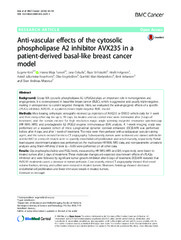Anti-vascular effects of the cytosolic phospholipase A2 inhibitor AVX235 in a patient-derived basal-like breast cancer model
Permanent link
https://hdl.handle.net/10037/9654Date
2016-03-07Type
Journal articleTidsskriftartikkel
Peer reviewed
Author
Kim, Eugene; Tunset, Hanna Maja; Cebulla, Jana; Vettukattil, Muhammad Riyas; Helgesen, Heidi; Feuerherm, Astrid Jullumstrø; Engebråten, Olav; Mælandsmo, Gunhild; Johansen, Berit; Moestue, Siver AndreasAbstract
Background
Group IVA cytosolic phospholipase A2 (cPLA2α) plays an important role in tumorigenesis and angiogenesis. It is overexpressed in basal-like breast cancer (BLBC), which is aggressive and usually triple-negative, making it unresponsive to current targeted therapies. Here, we evaluated the anti-angiogenic effects of a specific cPLA2α inhibitor, AVX235, in a patient-derived triple-negative BLBC model.
Methods
Mice bearing orthotopic xenografts received i.p. injections of AVX235 or DMSO vehicle daily for 1 week and then every other day for up to 19 days. Six treated and six control mice were terminated after 2 days of treatment, and the tumors excised for high resolution magic angle spinning magnetic resonance spectroscopy (HR MAS MRS) and prostaglandin E2 (PGE2) enzyme immunoassay (EIA) analysis. A 1-week imaging study was performed on a separate cohort of mice. Longitudinal dynamic contrast enhanced (DCE)-MRI was performed before, after 4 days, and after 1 week of treatment. The mice were then perfused with a radiopaque vascular casting agent, and the tumors excised for micro-CT angiography. Subsequently, tumors were sectioned and stained with lectin and for Ki67 or α-smooth muscle actin to quantify endothelial cell proliferation and vessel maturity, respectively. Partial least squares discriminant analysis was performed on the multivariate HR MAS MRS data, and non-parametric univariate analyses using Mann–Whitney U tests (α = 0.05) were performed on all other data.
Results
Glycerophosphocholine and PGE2 levels, measured by HR MAS MRS and EIA, respectively, were lower in treated tumors after 2 days of treatment. These molecular changes are expected downstream effects of cPLA2α inhibition and were followed by significant tumor growth inhibition after 8 days of treatment. DCE-MRI revealed that AVX235 treatment caused a decrease in tumor perfusion. Concordantly, micro-CT angiography showed that vessel volume fraction, density, and caliber were reduced in treated tumors. Moreover, histology showed decreased endothelial cell proliferation and fewer immature vessels in treated tumors.
Conclusions
These results demonstrate that cPLA2α inhibition with AVX235 resulted in decreased vascularization and perfusion and subsequent inhibition of tumor growth. Thus, cPLA2α inhibition may be a potential new therapeutic option for triple-negative basal-like breast cancer.
Group IVA cytosolic phospholipase A2 (cPLA2α) plays an important role in tumorigenesis and angiogenesis. It is overexpressed in basal-like breast cancer (BLBC), which is aggressive and usually triple-negative, making it unresponsive to current targeted therapies. Here, we evaluated the anti-angiogenic effects of a specific cPLA2α inhibitor, AVX235, in a patient-derived triple-negative BLBC model.
Methods
Mice bearing orthotopic xenografts received i.p. injections of AVX235 or DMSO vehicle daily for 1 week and then every other day for up to 19 days. Six treated and six control mice were terminated after 2 days of treatment, and the tumors excised for high resolution magic angle spinning magnetic resonance spectroscopy (HR MAS MRS) and prostaglandin E2 (PGE2) enzyme immunoassay (EIA) analysis. A 1-week imaging study was performed on a separate cohort of mice. Longitudinal dynamic contrast enhanced (DCE)-MRI was performed before, after 4 days, and after 1 week of treatment. The mice were then perfused with a radiopaque vascular casting agent, and the tumors excised for micro-CT angiography. Subsequently, tumors were sectioned and stained with lectin and for Ki67 or α-smooth muscle actin to quantify endothelial cell proliferation and vessel maturity, respectively. Partial least squares discriminant analysis was performed on the multivariate HR MAS MRS data, and non-parametric univariate analyses using Mann–Whitney U tests (α = 0.05) were performed on all other data.
Results
Glycerophosphocholine and PGE2 levels, measured by HR MAS MRS and EIA, respectively, were lower in treated tumors after 2 days of treatment. These molecular changes are expected downstream effects of cPLA2α inhibition and were followed by significant tumor growth inhibition after 8 days of treatment. DCE-MRI revealed that AVX235 treatment caused a decrease in tumor perfusion. Concordantly, micro-CT angiography showed that vessel volume fraction, density, and caliber were reduced in treated tumors. Moreover, histology showed decreased endothelial cell proliferation and fewer immature vessels in treated tumors.
Conclusions
These results demonstrate that cPLA2α inhibition with AVX235 resulted in decreased vascularization and perfusion and subsequent inhibition of tumor growth. Thus, cPLA2α inhibition may be a potential new therapeutic option for triple-negative basal-like breast cancer.
Description
Publisher's version, source: http://doi.org/10.1186/s12885-016-2225-1.


 English
English norsk
norsk